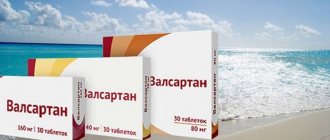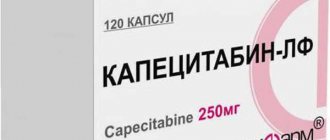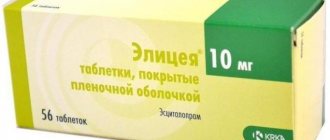Valsacor is a drug that lowers blood pressure. The medicine is available in tablet form in the following variations:
- Valsacor 40 mg;
- Valsacor 80 mg;
- Valsacor N 80 mg;
- Valsacor 160;
- Valsacor ND 160;
- Valsacor N 160.
The name of each drug indicates the concentration of the active substance in one tablet - valsartan, the addition of the letter “H” indicates the presence of hydrochlorothiazide in the amount of 12.5 mg, and the combination “ND” - a dose of hydrochlorothiazide 25 mg.
Pharmacological action of Valsacor
According to the instructions, Valsacor is an antihypertensive drug that affects specific angiotensin 2 receptors. The active component of the drug, valsartan, is a strong AT1 receptor antagonist; as a result of its action, the amount of free angiotensin 2 in the blood plasma increases and AT2 receptors are stimulated.
Valsacor produces a pronounced antihypertensive effect, reduces total peripheral vascular resistance, and helps normalize systolic pressure and cardiac output.
The drug does not affect the heart rate, while effectively improving the condition of patients with heart failure, helping to reduce shortness of breath, breath sounds and swelling; these effects are often voiced by reviews of Valsacor.
Valsacor H and Valsacor ND, in addition to the main substance valsartan, contain an additional component - hydrochlorothiazide. These components complement each other's therapeutic effects and reduce the risk of side effects.
Hydrochlorothiazide is a diuretic drug belonging to the thiazides group. This component has a pronounced hypotensive effect, enhances the excretion of potassium, water, chlorine and sodium.
14 days after the start of treatment with the drug, a significant antihypertensive effect is observed, as evidenced by reviews of Valsacor. The maximum result is observed at 4-5 weeks of taking the drug. The effect of Valsacor lasts for 24 hours after taking one dose.
Both valsartan and hydrochlorothiazide undergo rapid absorption from the digestive tract. About 40-70 percent of hydrochlorothiazide binds to plasma albumin, and valsartan binds to 98 percent. The active component of Valsacor is excreted mostly through feces and less through urine.
Pharmacokinetics
Valsacor tablets are intended for oral administration. After use, the tablet enters the gastrointestinal tract, where it breaks down into components under the influence of gastric juice. Binding to blood proteins is 60%. The components of the drug are excreted through the kidneys and intestines.
Bioavailability is 23%. The maximum hypotensive effect is observed 4 hours after administration.
Hydrochlorothiazide does not have a significant effect on the pharmacokinetic properties of valsartan.
The half-life is 9 hours.
Methods of using Valsacor and dosage
According to the instructions, Valsacor is prescribed by a doctor based on the patient’s diagnosis. The exact doses are selected depending on the degree of the hypotensive effect and individual sensitivity to the drug.
Thus, for the treatment of arterial hypertension, the dosage is usually 80 mg per day, which can be divided into 2 doses, although a single dose is also allowed. A month after the start of treatment with Valsacor, the effects of the medication on the patient’s condition are assessed, after which the dose is adjusted. The maximum amount of the drug per day is 160 mg per dose.
If treatment with Valsacor at a dose of 160 mg per day is not effective, Valsacor N is prescribed in the most appropriate dosage to enhance the hypotensive effect.
For patients suffering from liver dysfunction (without bile stasis) and kidneys (with creatinine clearance more than 30 ml per minute), dosages are not adjusted.
For the treatment of heart failure, the initial dose is 80 mg per day, divided into 2 doses (40 mg each), but over time it is increased to 160 mg per dose every 12 hours. In this case, it is necessary to take into account the individual tolerance of valsartan. Do not exceed the dosage of 320 mg per day.
If concomitant diuretic therapy is used, the dose of the drug can be a maximum of 160 mg.
After a heart attack, the drug is taken 12 hours later, and the dose is 40 mg per day, which is divided into 2 doses. For this purpose, it is better to use Valsacor 40 tablets, which are divided into 2 halves by a notch. Taking into account the patient's tolerance to valsartan, the dose is gradually increased. 320 mg of the drug is the maximum allowable amount per day.
Valsacor 160 or N is prescribed in dosages appropriate for the treatment of a particular patient. Most often, these medications are taken once a day, one tablet.
Brief information about the medicine
Release form
The drug is produced in the form of tablets intended for oral administration. The tablets are coated with a thin film coating.
Each tablet is packaged in an individual blister cell. Tablets are available with different amounts of active substance: 80 mg, 160 mg, 320 mg. The packages differ in appearance and name. The kit includes instructions for using Valsacor.
Composition of the drug
The main active ingredient of Valsacor is valsartan.
Other components of the drug:
- lactobiose;
- polyvinylpyrrolidone;
- colloidal silicon dioxide;
- anhydrous silica;
- microcrystalline cellulose;
- Solutab;
- magnesium stearate.
The shell includes:
- food additive E172 red;
- polyethylene glycol 4000;
- titanium dioxide;
- hydroxypropyl methylcellulose.
The tablets with the names Valsacor N80, N160, ND160 contain two main components: valsartan and hydrochlorothiazide.
Other components of the drug:
- colloidal silicon dioxide;
- anhydrous silica;
- microcrystalline cellulose;
- polyvinylpyrrolidone;
- magnesium stearate;
- Solutab;
- lactobiose.
The shell consists of:
- titanium dioxide;
- food additive E172 yellow, red;
- hydroxypropyl methylcellulose;
- polyethylene glycol 4000.
Packaging of Valsacor tablets
pharmachologic effect
Valsacor lowers blood pressure and has antihypertensive properties.
Terms and conditions of storage
It is recommended to store the medicine in a place away from children. Storage temperature should not exceed 25 degrees.
It is recommended to keep the drug in its packaging. The shelf life of the medicine is 3 years from the date of manufacture. After the expiration date, the drug must be disposed of in accordance with sanitary standards.
The shelf life of Valsacor N80, N160, ND160 is 2 years from the date of manufacture.
Conditions for dispensing from a pharmacy
The drug is sold in pharmacies only with a doctor's prescription.
Price of tablets
The cost of Valsacor is 250 rubles. Valsacor N80 costs 230 rubles, Valsacor N160 – 300 rubles, Valsacor ND160 – 375 rubles.
Side effects of Valsacor
According to reviews of Valsacor, such side effects as a result of taking the medicine are known, such as:
- bacterial and viral infections: sinusitis, pharyngitis, rhinitis;
- nausea, dizziness, vomiting, cough, headache, disturbances in the digestive tract, abdominal pain, arthralgia, myalgia, increased fatigue;
- an increase in the level of potassium ions in the blood plasma, the appearance of skin allergic reactions, and impaired renal function, although these symptoms are extremely rare.
When treated with Valsacor N and ND, undesirable side effects may occur, provoked by an additional element - hydrochlorothiazide (in addition to the above effects of valsartan), such as:
- from the liver: jaundice and cholestasis;
- from the cardiovascular system: heart rhythm disturbances, angina attacks, anemia, significant decrease in blood pressure, thrombocytopenia;
- from the central nervous system: changes in sleep and wakefulness, emotional lability, paresthesia;
- allergic manifestations: Lyell's syndrome, Stevens-Johnson syndrome, Quincke's edema;
- other disorders: hypokalemia or hyponatremia, increased levels of glucose, urea, bilirubin, creatinine in the blood plasma, decreased hearing, slight vision, increased sweating, tinnitus.
Drug compatibility
The medication should not be taken together with potassium-sparing diuretics or potassium-containing drugs, as this will lead to an excess of potassium. Taking drugs together often provokes a strong decrease in blood pressure.
The blood pressure drug Valsacor with hydrochlorothiazide affects the pharmacological properties of a number of other medications:
- increases the toxicity of salicylic acid derivatives;
- provokes the development of adverse reactions of cardiac drugs;
- increases the effectiveness of peripheral muscle relaxants;
- increases the cardiotoxicity and neurotoxicity of lithium-containing drugs;
- reduces the effectiveness of antidiabetic drugs, anti-gout drugs, Norepinephrine, Adrenaline;
- reduces the excretion of cytotoxic drugs by the kidneys;
- reduces the degree of quinidine excretion;
- increases the likelihood of developing an allergic reaction to Allopurinol.
The antihypertensive effect of the drug based on hydrochlorodiazide increases under the influence of vasodilators, barbiturates, tricyclics, adrenergic blockers, phenothiazine neuroleptics, and ethyl alcohol.
When taken together with Methyldopa, the risk of destruction of red blood cells increases.
Combined use with Kolestyramine reduces the degree of absorption of Valsacor.
Contraindications for use
The drug is contraindicated if the patient is hypersensitive to its components, as evidenced by reviews of Valsacor. The medicine is also not prescribed to pregnant and lactating women and children under 18 years of age. It is not recommended to take the drug for persons with lactose intolerance and galactosemia.
The drug is contraindicated in patients with electrolyte imbalances, including refractory hypokalemia (decreased potassium concentration), symptomatic hyperuricemia (increased blood urate levels) and decreased blood sodium levels.
According to the instructions, Valsacor is prescribed with caution to patients with liver or kidney failure, arterial hypertension.
Analogs
Situations often arise when original products are not available in the pharmacy. In order not to delay treatment, you can use an analogue of this drug. The instructions for the drug allow this. Note that in any pharmacy you can find drugs that are good analogues of Valsacor. If we talk about specific medications, can be called analogues of this medication :
- Valsafors;
- Walz;
- Valsartan N.
Overdose
Excessive use of the drug can provoke the development of a phenomenon such as drug overdose. It is accompanied by characteristic symptoms:
- excessive decrease in pressure in blood vessels;
- shock;
- lethargy;
- convulsions.
Currently, there are no clinically documented cases of overdose. But if this condition is likely to develop, you need to rinse your stomach and take enterosorbent.
Price
The cost of this medicine is proportional to the number of tablets and the content of the active ingredient. 30 tablets of Valsacor with a dosage of 80 mg can be purchased for 250-300 rubles.
A package of Valsacor, which contains 90 tablets with a concentration of valsartan of 160 mg, costs about 700 rubles.
Compound
Each Valsacor tablet contains the active ingredient and auxiliary ingredients. The active substance is valsartan. Its content varies depending on the type of drug.
Don't tolerate high blood pressure
Now hypertension can be cured by restoring blood vessels...
>
Additional Ingredients:
- milk sugar monohydrate;
- povidone;
- silicon dioxide in the form of a fine mixture;
- magnesium stearate;
- food colorings;
- titanium dioxide.




